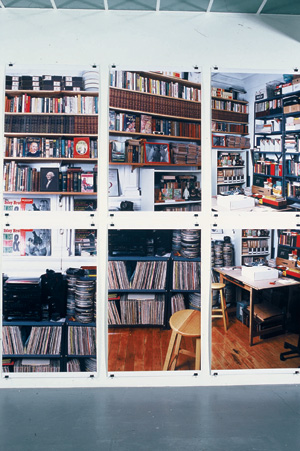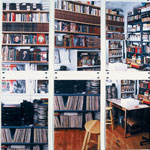“Madame Bovary, c’est moi,” Flaubert famously remarked.
Allen Ruppersberg can say the same thing about his library—or rather, the compendium of high and low, vinyl and film, hard-bound philosophical tomes and comic books that comprise his personal archive. His The New Five Foot Shelf, on view in person at Texas Gallery, and online as part of Dia Foundation’s web-based projects, is both a rumination on the function of knowledge in contemporary society and a provocative confession, a la Augustine, about his core beliefs.
The New Five Foot Shelf revives Charles Eliot’s idea that a five-foot shelf of books (containing, in Eliot’s original, fifty volumes, four hundred and eighteen titles, three hundred authors, plus reading courses and seventy-six thousand references) would provide all any student would need for a basic education. Ruppersberg took this early twentieth-century precursor to the recent great book lists literally, constructing his own fifty-volume testament to the power of a literary core. But his updated shelf (it stands alone, open to white-gloved inspection, on a long table in Texas gallery, and is partially viewable online) does not avail itself to Eliot’s educational goals.
The first volume is a facsimile reproduction of Eliot’s original introduction. Each succeeding book contains a table of contents, which leads, as the first several pages are turned, to threads of five “narratives” about given subjects. Heading up each volume, the first begins, “Honey I rearranged the collection….” The rationalizations that complete the sentence range from the eccentric (“to show artists who were popular in the 80’s but aren’t now and won’t be later”), to the philosophic (“because I’m tired of looking at the past”) to the kvetchy (“but you would never notice”).
The second thread, “When in Doubt Go to the Movies,” consists of citations and quotations about categorization. In the third, “Once Upon a Time When Books Where Famous,” each thread begins with “Some men… and ends with “Others do not” (“Some men seek disciples. Others do not.”). Ruppersberg’s fourth line of thought is titled The Three Marcels (Duchamp, Proust, and Broodthaers—all important inspirations for this artist’s own image-text artistry). A final flow of excerpts of personal correspondence completes each volume. But in each volume the mantra-like intro and the wide-ranging entries that follow it quickly peter out. The bulk of each volume is in fact largely empty, a desert of blank pages interrupted only occasionally by a facsimile newspaper obituary of an artist, musician, or performer whose career coincided with Ruppersberg’s interests or is reflected in his archive.
Surrounding this shelf in Texas Gallery (and excerpted online) is a wall-to-wall, roughly life-size mapping, in large photographs, of Ruppersberg’s archive as it existed from 1986 to 2001 in his New York studio. It is here that the highly detailed flatness of the photo-mural sheets of Ruppersberg’s archive meet their match, in the voluminous sense of unfolding blankness that follows the first dozen or so informational pages. They are the inverse of the photomural, as heavily textured and formatted as the photographs are informational, but withholding all information, just as the photomural is at best a casual approximation of the façade of Ruppersberg’s collection.
In his quirky, literalist way, Ruppersberg seems to thus exclude both of the tools of his trade—image (photograph) and text (bound volumes) from the seat of knowledge, even as he uses both of them to make his case. In this stalemate between word and image, both the lived-in disorder of overstacked metal and wood shelves and the absolute clarity of the cloth-bound volumes fail his smell test. What then? Perhaps his first line is also his tip-off. To be a collector is to rearrange, is to conserve and sustain. It is a hopelessly optimistic gesture, like the early wunderkammer collectors who thought they could assemble enough representative examples of the work of nature and man to understand the working of the world. Ruppersberg does not provide an easy answer, preferring to distill his shelf into an essay on the life (and death) of the mind, one that fulfills the Giorgio De Chirico citation that serves as the shelf’s constant introduction:
He lives there in two rooms which he had covered from ceiling to floor with most strange and troubling designs that made certain distinguished critics repeat for the thousandth time: it is nothing but literature!
Images courtesy Texas Gallery.
Christopher French is an artist and writer living in Houston.




